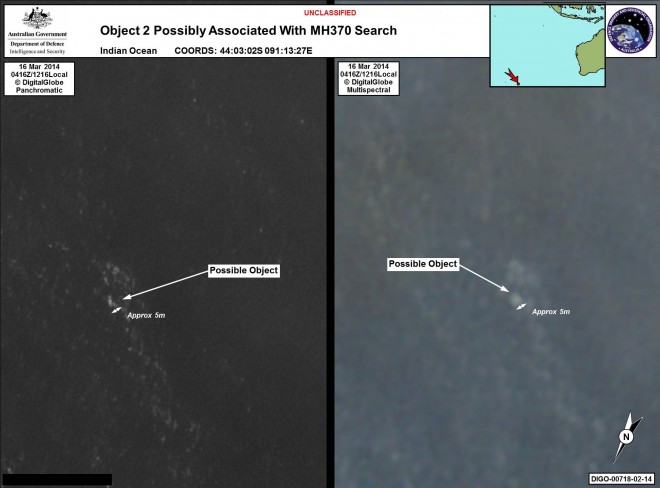Sense of desperation as MH370 search enters third week

In this March 16, 2014 satellite imagery provided by Commonwealth of Australia – Department of Defence on Thursday, March 20, 2014, a floating object is seen at sea next to the descriptor which was added by the source. Australia’s government reported Thursday, March 20, 2014 that the images show suspected debris from the missing Malaysia Airlines jetliner floating in an area 2,500 kilometers (1,550 miles) southwest of Perth Australia. (AP Photo/Commonwealth of Australia – Department of Defence)
PERTH – Australian rescuers stepped up the search for Malaysian Flight MH370 as pressure mounted Saturday to find the missing plane that vanished two weeks ago and has defied the best efforts of modern technology to track it down.
Six planes, including four Orion anti-submarine aircraft packed with state-of-the-art surveillance equipment, joined the search for debris from the aircraft over a remote stretch of the Indian Ocean, 2,500 kilometers (1,500 miles) southwest of Perth.
Chinese, British and Australian naval ships were all steaming to the same area where two floating objects – possibly plane wreckage – were picked out on grainy satellite pictures.
With planes from China and Japan also expected to join the hunt, the sudden concentration of resources on the basis of such inconclusive evidence reflects growing desperation after 14 days of piecemeal progress.
There have been no sightings of interest since Thursday, when Australia released the satellite photos taken on March 16.
Article continues after this advertisementSome experts warn the larger of the two objects – measuring an estimated 24 meters (79 feet) across – could be a shipping container, while Australian Deputy Prime Minister Warren Truss cautioned that any possible debris may have sunk.
Article continues after this advertisement“Something that was floating on the sea that long ago may no longer be floating. It may have slipped to the bottom,” he said.
After Australian and Malaysian officials hailed the satellite images as the most “credible” lead to date, failure to find anything soon will be a body blow to a search operation already tainted by false leads and dead ends.
– Cockpit ‘transcript’ published –
Britain’s Telegraph newspaper published what appeared to be the full transcript of communications with Flight MH370’s cockpit crew up until the moment it dropped off civilian radar.
The transcript, which ended with the final words “All right, good night” – believed to have been spoken by the co-pilot – contained no fresh clues to what diverted MH370 from its intended flight path from Kuala Lumpur to Beijing on March 8.
Malaysian investigators have stuck to their assumption that it was the result of a “deliberate action” by someone on board.
Three scenarios have gained particular attention: hijacking, pilot sabotage, and a sudden mid-air crisis that incapacitated the flight crew and left the plane to fly on auto-pilot for several hours until it ran out of fuel and crashed.
Finding wreckage in the remote southern Indian Ocean would undermine the hijacking theory, which many of the relatives of the 227 passengers on board continue to cling to.
Sarah Bajc, the partner of American passenger Philip Wood, voiced concern that the sudden focus on a particular section of the Indian Ocean was happening at the expense of a land search along a northern route the plane may have taken over South and Central Asia.
“I believe, and I think many people believe, the passengers are being held for some other purpose. But so far that doesn’t seem to be listened to,” Bajc told CNN
“If there’s a chance it was taken by an abductor of some sort, then we should be putting at least some of our resources towards looking on land,” she added.
On Friday five planes, including military P3 Orions, criss-crossed 23,000-square kilometers (8,800-square miles) of ocean without any sightings of wreckage, and the search area has now been widened.
The distance from Australia’s west coast allows the Orions only about two hours of actual search time before they must turn around with enough fuel to get back to Perth.
– Ultra long-range jets search seas –
Two ultra long-range commercial jets being used on Saturday can stay in the area for five hours.
“With any luck we’ll find something shortly,” said Australian Flight Lieutenant Russell Adams.
As it enters its third week, the search for MH370 has become one of the longest – and certainly largest – in modern aviation history.
No confirmed wreckage was ever found of a Korean Air jetliner that exploded in mid-air over the Andaman Sea in 1987 as the result of a bomb placed on board by North Korean agents.
Expectations based on advances in technology, coupled with the modern era’s relentless 24-hour media coverage, would seem to rule out public acceptance of the idea that MH370 will never be found.
“This is going to be a long-haul effort,” Malaysian Transport Minister Hishammuddin Hussein said Friday.
Scott Hamilton, managing director of US-based aviation consultancy Leeham Co., said the investigation would simply continue for as long as it takes.
“This is, in all probability, a criminal act, and thereby presumed murder of more than 230 people,” Hamilton said.
“Worse, if this is some kind of terror event that is a precursor to something bigger in the future, authorities will presumably do all they can to make this determination and work to prevent it – whatever ‘it’ is,” he added.
Malaysia has asked the FBI to help recover data it said was deleted from a home flight simulator belonging to the plane’s chief pilot, Captain Zaharie Ahmad Shah, but otherwise no evidence has emerged to implicate him.